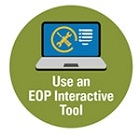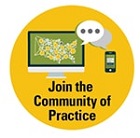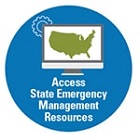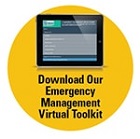|
Using Federal Resources and Community Preparedness Officers to Support Youth Emergency Preparedness Efforts
Schools and school districts are not alone as they take steps to create and maintain emergency operations plans (EOPs) that address a variety of threats and hazards. As EOPs continually evolve based on lessons learned from emergency exercises and actual emergency incidents, schools and school districts may need to rely on the expertise of partners at the school, regional, state, and federal levels, including but not limited to the U.S. Department of Education (ED) and the U.S. Department of Homeland Security’s (DHS) Federal Emergency Management Agency (FEMA).
ED, the REMS TA Center, and FEMA remain committed to offering various types of resources and programs that schools, school districts, and their community partners can use as they work to ensure that EOPs remain up to date and that key stakeholders understand not only their roles and responsibilities in the event of an emergency but also their role in overall emergency preparedness.
To help broaden awareness of the availability of free resources from the federal government focused on school safety, the REMS TA Center partnered with the Region 1 Community Preparedness Office that serves Connecticut, Maine, Massachusetts, New Hampshire, Rhode Island, and Vermont. As part of FEMA’s Individual and Community Preparedness Division, their efforts highlight one of the many ways in which Community Preparedness Officers (CPOs) can provide support to schools and districts to increase youth preparedness.
Can you describe what the CPO does within each region?
FEMA CPO: The role varies in each region. Generally, the CPO works to connect individuals and groups with FEMA preparedness training, materials, and resources through webinars, newsletters, and participation in community events. The CPO also acts as a subject matter expert and resource in developing and maintaining youth-focused and other programs.
What youth preparedness resources are available?
FEMA CPO: STEP, Pedro, and Teen CERT are all resources schools can promote, as well as YPC.
The Student Tools for Emergency Planning (STEP) Curriculum inspires youth to prepare. The newly updated STEP is a modular emergency preparedness curriculum with fun activities that can be used in many different settings, inside and outside of school. Geared for students in fourth grade and above, the program guides students on how to create emergency kits and family communication plans.
Prepare With Pedro: An Adventure in Emergency Preparedness Game is a game children can play on their own, with a friend, with a grown-up, or at school to learn how to identify different disasters, including disasters in their area, and how to prepare before and stay safe during a disaster.
The Community Emergency Response Team (CERT) Program is a national program of volunteers trained in disaster preparedness and emergency response. Volunteers come from all ages and all walks of life, including teenagers. Through Teen CERT, students can serve their community and help take care of school and home.
The Youth Preparedness Council (YPC) was created in 2012 to bring together youth leaders interested in supporting disaster preparedness and making a difference in their communities by completing disaster preparedness projects locally. The council supports FEMA’s commitment to involve America’s youth in preparedness-related activities.
Are the tools you create for schools customizable?
FEMA CPO: Yes and no. You can use only some aspects of the tools or break them up over multiple days. Most tools have information about how to prepare for specific disasters, so, for example, a Boston school could focus on winter storm preparedness and omit earthquake preparedness, and a San Franciso school could do the reverse. That said, the materials are meant to be one-size-fits-all and not require a lot of customization.
What contact information should schools, local education agencies, or state education agencies use if they need support with youth preparedness or some other emergency preparedness focus area?
FEMA CPO: For Region 1, they can email us. If schools have other needs that we cannot directly address, we can triage those questions and find the right person to address their specific need. People outside of Region 1 can use the interactive map on our website to gather information about their regional office and local contact information.
If you need assistance finding state and federal partners and/or federal programs or initiatives related to school safety and EOP development, use the resources listed below:
- Visit the REMS TA Center’s State Map of Emergency Management Resources to access state points of contact available to support school safety and emergency preparedness-focused efforts.
- Visit the About tab on the REMS TA Center Website and click Programs We Support to view other federal emergency preparedness programs geared towards education agencies.
- Visit SchoolSafety.gov, a public-facing vehicle of the Federal School Safety Clearinghouse, an interagency effort among ED, the Department of Health and Human Services, DHS, and the Department of Justice.
|









